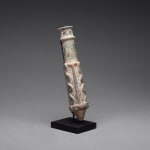Elamite Bronze Handle, 900 BCE - 800 CE
Bronze
16.8 x 3.2 cm
6 5/8 x 1 1/4 in
6 5/8 x 1 1/4 in
FZ.371
Further images
Elam was an ancient kingdom of Asia, situated north of the Persian Gulf and east of the Tigris River, and corresponding approximately to the present-day province of Khuzistan in Iran....
Elam was an ancient kingdom of Asia, situated north of the Persian Gulf and east of the Tigris River, and corresponding approximately to the present-day province of Khuzistan in Iran. The capital of Elam and its most fabled city was Sûsa, today the city of Shûsh. This powerful empire has been overshadowed in history by the rival kingdoms of Babylon and Assyria. However, their extraordinary metalwork survives to this day, a testament to the expertise of their craftsman.
What was the purpose of this handle? Was it once attached to a sword? Perhaps it held a ritual staff. Clearly, this is an important bronze work that served a use greater than itself. Most likely it was involved in ritual ceremonies. If it was a sword handle, perhaps it was used for sacrificial offerings. While we will never know the real meaning behind this spectacular piece, we are more than able to revel in its beauty. The bronze has taken on a rich greenish patina over the ages. The lower half of the handle has been segmented into four sections, each divided by elevated ridges incised with a “v” shaped motif. Four winding snakes slither their way across these segments, contributing to the handles symbolic significance. The three holes at the top would have help secure in place the object it was once attached to. Long ago, this handle was used to hold something else; today, its beauty alone is sufficient. We can appreciate the handle not for its function, but for its stellar craftsmanship.
What was the purpose of this handle? Was it once attached to a sword? Perhaps it held a ritual staff. Clearly, this is an important bronze work that served a use greater than itself. Most likely it was involved in ritual ceremonies. If it was a sword handle, perhaps it was used for sacrificial offerings. While we will never know the real meaning behind this spectacular piece, we are more than able to revel in its beauty. The bronze has taken on a rich greenish patina over the ages. The lower half of the handle has been segmented into four sections, each divided by elevated ridges incised with a “v” shaped motif. Four winding snakes slither their way across these segments, contributing to the handles symbolic significance. The three holes at the top would have help secure in place the object it was once attached to. Long ago, this handle was used to hold something else; today, its beauty alone is sufficient. We can appreciate the handle not for its function, but for its stellar craftsmanship.





